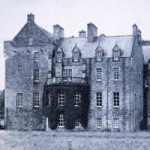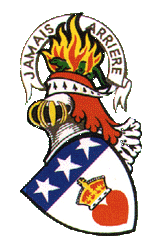|
Cavers, a Teviotdale parish of Roxburghshire, containing, in its northern
division, the village of Denholm, 5 miles NE of Hawick, and, in its
southern division, Shankend station, 7 miles SSE of Hawick. Very irregular
in shape, being cut in two by Kirkton parish except for a narrow
connecting link to the E, it is bounded NW by Wilton and Minto, E by
Bedrule and Hobkirk, S by Castleton, and W by Teviothead, Kirkton, and
Hawick.
Dr Chalmers was assistant minister from
1801 to 1803; but the name most closely associated with Cavers is that of
the scholar-poet, John Leyden (1775-1811). The low-thatched cottage at
Denholm in which he was born is still occupied; but Henlawshiel, at the
base of Ruberslaw, whither his father removed in 1776, has been long
demolished. Antiquities are four or five prehistoric hill-forts, remains
near Ormiston of Cocklaw Castle, and, in the southern division, about 3
miles of the Catrail; whilst a crag towards the summit of Ruberslaw is
pointed out as ' Peden's Pulpit.'
 Cavers House, a little SE of the parish
church, on the site of a castle inhabited by the Baliols in the 12th and
13th centuries, is a large rectangular pile, baronial in aspect, with
walls of great thickness and small old-fashioned windows. Its oldest
portion, a square tower, was built by Sir Archibald Douglas, younger son
of that valiant Earl of Douglas who conquered and fell at
Otterburn (1388), and whose banner is here preserved along with the trophy won from
Harry Hotspur. Sir Archibald's descendants were hereditary Sheriffs of
Teviotdale, and also sometimes Wardens of the Marches, down to 1745; with
the twentieth of them, James Douglas, Esq. of Cavers (1822-78), the male
line became extinct. There upon the estate-9840 acres, valued at £7937 per
annum-passed to his niece, Miss Mary Malcolm, who in 1879 married Capt.
Edward Palmer. Cavers House, a little SE of the parish
church, on the site of a castle inhabited by the Baliols in the 12th and
13th centuries, is a large rectangular pile, baronial in aspect, with
walls of great thickness and small old-fashioned windows. Its oldest
portion, a square tower, was built by Sir Archibald Douglas, younger son
of that valiant Earl of Douglas who conquered and fell at
Otterburn (1388), and whose banner is here preserved along with the trophy won from
Harry Hotspur. Sir Archibald's descendants were hereditary Sheriffs of
Teviotdale, and also sometimes Wardens of the Marches, down to 1745; with
the twentieth of them, James Douglas, Esq. of Cavers (1822-78), the male
line became extinct. There upon the estate-9840 acres, valued at £7937 per
annum-passed to his niece, Miss Mary Malcolm, who in 1879 married Capt.
Edward Palmer.
Other mansions are Orchard, Ormiston
House, and Stobs Castle, which stand respectively 2¾ miles E by N, 2½ E by
S, and 4½ S, of Hawick.
The old parish church, ¼ mile NNE of
Cavers House, is a long plain building, with traces of Norman and First
Pointed work; young Leyden made it his week-day study, and played in it
some most unholy pranks. A little to the westward, and 2½ miles ENE of
Hawick, is the present church, erected in 1822, and containing 500
sittings. Denholm has also a Free church (364 sittings).
Cavers House. Built mainly between 1750 and 1884, the large mansion
known as Cavers House has grown round a lofty tower which now forms its
SE. side; but this tower, which is known locally as the "Warden's
Tower", may itself be a secondary construction imposed upon the remains
of still earlier building. Unfortunately the tower has undergone such
extensive alteration that little or nothing remains by which it can be
dated. Its size, however, would suggest a date in the later 15th or
early 16th century.
On plan it consists of an oblong block
measuring about 50 ft. along the S wall by 29 ft. over the E gable; the
W gable, however, shows a re-entrant angle at its S end measuring 8 ft.
6 in. from N to S by 3 ft. 6 in. from E to W. The walls vary from 4 ft.
6 in. to 8 ft. 6 in. in thickness. In height there are five storeys and
an attic. Both attic and battlements are wholly modern while the two
floors beneath were rebuilt in the 17th century, but the three lower
floors probably date from about 1500. The masonry is rubble for the most
part, but in the lowest part of the S wall there is a considerable
amount of ashlar in large blocks. None of the windows is earlier than
the 17th century and the majority are quite modern.
The tower
has been modernised inside. In 1890 the removal of the vault above the
first floor disclosed the presence of a fine 13th-century piscina-niche
near the east end of the south wall. This appeared to be in situ, and
hence it would appear that some part of the wall containing it was older
than the tower. It may have been a vestige of the Baliol castle of which
mention is made below. The piscina niche has a foiled head, and when
first uncovered was enclosed by a plain circular moulding which an
ignorant mason removed to make the feature flush with the wall. The
niche-opening measures 2 ft. 3 in. in height, 1 ft. 4 1/4 in. in width,
and 7 1/4 in. deep, while the sill, shaped on the dexter side as a
piscina and on the sinister side as a credence, projects about 3 in.
more, being set out on two moulded brackets formed like capitals of the
period, the lowest member of each being cone-shaped with a floriated end
and finishing downwards in a thumb-knot. Apart from this feature, the
interior of the tower contains nothing of interest.
The first
extension of the tower was a wing thrown out to the N in alinement with
the E gable; it was built about 1700, but was reconstructed in 1887.
In the 12th and 13th centuries Cavers belonged to the Baliols. In 1352-3
the lands of the barony were granted by David II to William, Lord
Douglas. As time went on certain parts of the barony were alienated, and
in 1511 James IV made a fresh grant of the free barony of Cavers to
James Douglas- this included the town of Cavers with the lands, castle,
manor and mill. The "castrum" of this latter charter is probably the
existing tower, and it is again mentioned in a charter of 1576-7.
(Reg Magni Sig Reg Scot 1984). In 1542 Cavers was burnt by Dacre
with the help of Sir Walter Scott of Branxholm (Acts Parl Scot), and in
1545 it figures in a list of places "brent, raced, and cast doune" by
Hertford (D Laing 1855; Haynes "Collection of State Papers", p.53).
Douglas dynasty for sale in the Borders
Published in the Borders Telegraph: 15 Oct 2013
The
ancient seat of the Douglas family in the heart of the Scottish Borders
is up for sale at offers over £300,000.
Cavers Castle, near
Hawick, is now an empty shell of a ruin despite being a 64-room, 100,000
acre residence in its heyday.
The property - set now in only 11 acres
- is thought to be attracting interest in the USA where there is a
strong Douglas clan association.
The majority of the 100,000 acres
has been sold over the years by the Palmer-Douglas family but Cavers
Castle itself which was the seat of the Douglas family for more than 300
years would provide an emotional pull.
A spokesman for
Melrose-based estate agents Retties said: “It is a once magnificent
Scottish Castle in 11 acres in need of complete restoration.
“All
that remains of the Castle are the bricks and mortar of the five storey,
south-easterly wing. Some of the walls are up to eleven feet in
thickness and detail around fireplaces and cornicing still remain.
“Existing plans are available proposing the restoration of the
Castle to a single dwelling family home.
“The plans are to create
a family home to a very high specification, with space, design and
amenities to meet today’s living requirements.
“Incorporating a
swimming pool, gymnasium, library and cinema, the design will contrast
modern architecture with the existing historic fabric, resulting in a
rejuvenated structure that can once again take its place amongst the
noteworthy buildings of the Scottish Borders.
“No formal
application has been submitted, but the local planning department have
indicated they would look favourably on the restoration of the castle
and would consider the existing or new design plan.”
The castle
was constructed around 1200 and first inhabited by the Balliols.
Clan Douglas, instrumental in banishing the Balliols from Scotland, were
granted the lands by King David 11 of Scotland in 1352.
Sir Archibald
Douglas, 3rd Earl of Douglas was responsible for the construction of
Cavers Tower, a traditional fortified Scottish tower, on the site of the
original castle after he succeeded to the earldom when James Douglas
fell at the Battle of Otterburn in 1388.
Cavers House was
inhabited by a branch of the Douglas family until the twentieth
descendent, James Douglas died in 1878 leaving no male heir. The
property passed to his niece Mary Malcolm who married Captain Edward
Palmer in 1879 and the property was substantially re-modelled as Cavers
House between 1881 and 1887.
The house eventually became disused
and was made available to the British Army for use in a demolition by
explosives exercise in 1953.
The army were partially successfully in
destroying Victorian section but made little impact on the 11-feet thick
walls of the older medieval section.
See also:
A. Townhead of Cavers B.
Douglas of Cavers c.
Cavers churches
Errors and Omissions
|
|
The Forum
|
|
What's new?
|
|
We are looking for your help to improve the accuracy of The Douglas
Archives.
If you spot errors, or omissions, then
please do let us know
Contributions
Many articles are stubs which would benefit from re-writing.
Can you help?
Copyright
You are not authorized to add this page or any images from this page
to Ancestry.com (or its subsidiaries) or other fee-paying sites
without our express permission and then, if given, only by including
our copyright and a URL link to the web site.
|
|
If you have met a brick wall
with your research, then posting a notice in the Douglas Archives
Forum may be the answer. Or, it may help you find the answer!
You may also be able to help others answer their queries.
Visit the
Douglas Archives Forum.
2 Minute Survey
To provide feedback on the website, please take a couple of
minutes to complete our
survey.
|
|
We try to keep everyone up to date with new entries, via our
What's New section on the
home page.
We also use
the Community
Network to keep researchers abreast of developments in the
Douglas Archives.
Help with costs
Maintaining the three sections of the site has its costs. Any
contribution the defray them is very welcome
Donate
Newsletter
Our newsletter service has been temporarily withdrawn.
|
|
|
|
|
|
|
|
|
|


